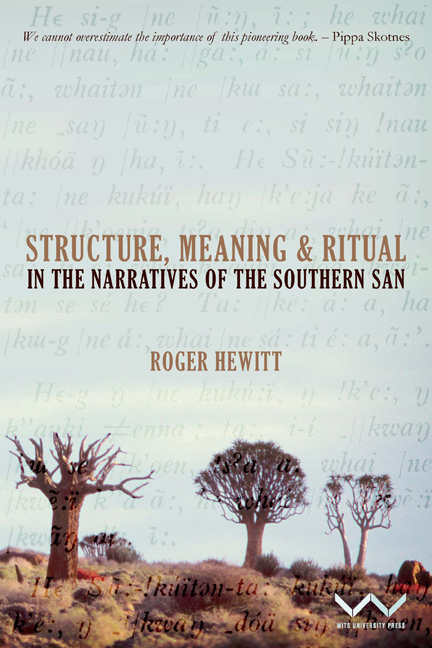Book contents
- Frontmatter
- Dedication
- Contents
- Acknowledgements
- Introduction
- 1 Ethnographic background
- 2 Introduction to the narratives: their context, performance and scope
- 3 Legends and the stories of !Khwa
- 4 Sidereal narratives: the story of the Dawn's Heart and his wife the Lynx
- 5 Animal narratives
- 6 |Kaggen in belief and ritual
- 7 The |Kaggen narratives (1): characters and content
- 8 The |Kaggen narratives (2): sequence and structure
- 9 |Kaggen in belief, ritual and narrative: a synthesis
- 10 Two |Kaggen narratives: compositional variations
- 11 The verbal surface: a note on the narrators
- Appendix A Girls’ puberty observances of the ǀXam
- Appendix B The shamans of the ǀXam
- Bibliography
- Index
- Frontmatter
- Dedication
- Contents
- Acknowledgements
- Introduction
- 1 Ethnographic background
- 2 Introduction to the narratives: their context, performance and scope
- 3 Legends and the stories of !Khwa
- 4 Sidereal narratives: the story of the Dawn's Heart and his wife the Lynx
- 5 Animal narratives
- 6 |Kaggen in belief and ritual
- 7 The |Kaggen narratives (1): characters and content
- 8 The |Kaggen narratives (2): sequence and structure
- 9 |Kaggen in belief, ritual and narrative: a synthesis
- 10 Two |Kaggen narratives: compositional variations
- 11 The verbal surface: a note on the narrators
- Appendix A Girls’ puberty observances of the ǀXam
- Appendix B The shamans of the ǀXam
- Bibliography
- Index
Summary
The majority of ǀXam narratives are about the !Xwe ǁna s'o !kʔe who were associated with certain animals. Many of the narratives describe communities of different groups, each having a common name like ‘the Jackals’ or ‘the Striped Mice’, living in close contact with each other, and all having human form although often with some of the attributes of the animals they will in time become. Where they live may be affected by their animal association – the Anteater lives in the ground, the Black Crow lives in a tree – but not how they live. They are all hunters and gatherers like the San.
Nearly 50 different creatures are represented in these stories, from insects to the larger animals such as the elephant and the rhinoceros. Antelope, much prized as game, are poorly represented; rhebok, springbok and wildebeest feature rarely as actors, other antelope not at all. Of the larger game animals only the quagga is given any prominence. Birds and the smaller animals such as the ratel, mouse, polecat etc., form the largest group but are distributed in such a way that single species tend to recur infrequently. The ostrich, blue crane, black crow, lizard and baboon all appear in several narratives but the animals which occur with most frequency are the lion, the jackal and the hyena.
Because the characters in these narratives are only ambiguously human, there is a tension between the apparent human society and the dispositions of the characters as animals. The stories therefore explore both natural history and, perhaps unconsciously, areas of stress in real life. If the characters in the stories are not really human at all, then, as was seen in the case of the story of Dawn's Heart and his wife, there may be times when their needs and propensities as animals will come to the fore in such a way as to shape their interaction with each other.
Not only will there be stress between husband and wife but also between in-laws out to protect the interests of their kin. Because of this, food, marriage and inter-family relationships are at the heart of this narrative tradition and seem to echo the concerns which were of special importance to the ǀXam.
- Type
- Chapter
- Information
- Publisher: Wits University PressPrint publication year: 2008



